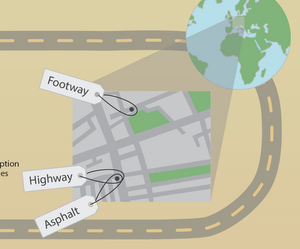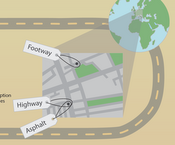Information
- Publication Type: Master Thesis
- Workgroup(s)/Project(s):
- Date: May 2017
- Date (Start): 7. June 2016
- Date (End): 30. May 2017
- TU Wien Library:
- Diploma Examination: 30. May 2017
- First Supervisor: Michael Wimmer
Abstract
This thesis presents a method to automatically estimate road-surface types based on crowd-sourced and open source data to give cyclists an overview of the road conditions along a cycle route.Automatic classification of land-cover has been an active research field in recent years and mainly focuses on the classification of areas based on digital satellite and aerial imagery. Performing classification of road-surfaces based on such images bears some special challenges because roads have a width of only a few pixels on these photos, which makes it difficult to successfully apply classical image-analysis methods. Problems are caused by mixed pixels, which do not belong to a single surface class exclusively. Due to objects occluding the street, like for example trees and cars, it is difficult to isolate the street’s actual surface from the rest of the image. This biases the classification procedure and may cause faulty results. Furthermore, aerial images of high spatial resolution are only available with a small range of spectral bands.
This thesis proposes an alternative approach for road-surface classification by utilizing open source data with a focus on data from the project OpenStreetMap (OSM). OSM is an online mapping project which collects geographical data and makes it available freely by providing a digital world map. Data is collected by users on a voluntary basis. OSM offers its users the possibility to add various properties to streets by making textual annotations. From these so-called tags it is possible to deduce road-surface properties for numerous roads by using methods from pattern recognition. The system is designed so it can be extended with additional data from other sources (e.g., height information) to improve classification results. Classification takes place at two levels, based on a coarse-to-fine-grained surface taxonomy.
The method was evaluated on different testing areas in Austria and Liechtenstein. At the coarse-grained level, up to 90% of streets were correctly classified. At the fine-grained level, up to 60% of streets were correctly classified. The advantage of the proposed method is that it is fast and applicable to regions worldwide at low cost, as long as sufficient OSM data for a certain region is available.
Additional Files and Images
Weblinks
No further information available.BibTeX
@mastersthesis{PODARAS-2017-ACRS,
title = "Automated Classification of Road-Surface Types Based on
Crowd-Sourced Data",
author = "Silvana Podaras",
year = "2017",
abstract = "This thesis presents a method to automatically estimate
road-surface types based on crowd-sourced and open source
data to give cyclists an overview of the road conditions
along a cycle route. Automatic classification of land-cover
has been an active research field in recent years and mainly
focuses on the classification of areas based on digital
satellite and aerial imagery. Performing classification of
road-surfaces based on such images bears some special
challenges because roads have a width of only a few pixels
on these photos, which makes it difficult to successfully
apply classical image-analysis methods. Problems are caused
by mixed pixels, which do not belong to a single surface
class exclusively. Due to objects occluding the street, like
for example trees and cars, it is difficult to isolate the
street’s actual surface from the rest of the image. This
biases the classification procedure and may cause faulty
results. Furthermore, aerial images of high spatial
resolution are only available with a small range of spectral
bands. This thesis proposes an alternative approach for
road-surface classification by utilizing open source data
with a focus on data from the project OpenStreetMap (OSM).
OSM is an online mapping project which collects geographical
data and makes it available freely by providing a digital
world map. Data is collected by users on a voluntary basis.
OSM offers its users the possibility to add various
properties to streets by making textual annotations. From
these so-called tags it is possible to deduce road-surface
properties for numerous roads by using methods from pattern
recognition. The system is designed so it can be extended
with additional data from other sources (e.g., height
information) to improve classification results.
Classification takes place at two levels, based on a
coarse-to-fine-grained surface taxonomy. The method was
evaluated on different testing areas in Austria and
Liechtenstein. At the coarse-grained level, up to 90% of
streets were correctly classified. At the fine-grained
level, up to 60% of streets were correctly classified. The
advantage of the proposed method is that it is fast and
applicable to regions worldwide at low cost, as long as
sufficient OSM data for a certain region is available.",
month = may,
address = "Favoritenstrasse 9-11/E193-02, A-1040 Vienna, Austria",
school = "Institute of Computer Graphics and Algorithms, Vienna
University of Technology ",
URL = "https://www.cg.tuwien.ac.at/research/publications/2017/PODARAS-2017-ACRS/",
}

 poster
poster thesis
thesis


